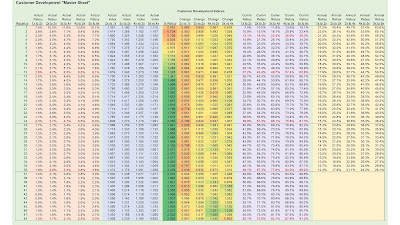The Master Sheet tells us the story of how well your brand executes Customer Development strategies.
There are two "heatmaps" embedded in the Master Sheet. Let's look at the series of columns on the far left side of the Master Sheet.
This series of columns represents the probability of a customer buying again next month, given current Recency/Frequency status. Look at the top row. The cells are green, meaning that customers are responsive in the month following a purchase. One might say "duh", and that wouldn't be an inappropriate response. However, we need to have a baseline for comparing customer performance. If recency = 1 and frequency = 1 (brand new buyer), the customer has a 7.4% chance of buying next month. Now read down a row ... if the customer doesn't purchase, the customer falls to recency = 2 and frequency = 1, and the repurchase rate (a yellow cell) drops to 3.8%. If the customer fails to purchase again, the customer falls to recency = 3 and frequency = 1. Here, the customer has a 2.5% chance of buying again next month. Already the customer is lapsing. We repeatedly learn about the importance of a credible Welcome program, don't we?
Read across the recency = 1 row. As the customer upgrades via additional purchases, the customer becomes more responsive. At frequency = 1 the customer has a 7.4% chance of buying next month. At frequency = 2, the customer has a 10.0% chance of buying again next month. At frequency = 3, the customer has a 11.8% chance of buying again next month. At frequency = 4, the customer has a 13.6% chance of buying again next month. At frequency = 5, the customer has a 15.1% chance of buying again next month. You continue to "develop" the customer after each purchase, causing the customer to become more responsive (and ultimately, more "loyal").
Look at the strange "green" cells at recency = 12 months. Incremental monthly response (for this brand) increases at recency = 12 months, recency = 24 months, and recency = 36 months. Why does this happen? This is a classic "seasonality" dynamic that is so important in Customer Development. Customers who bought a product last September, for instance, become more responsive the following September if the customer has yet to purchase by then. Every credible Customer Development program capitalizes on seasonality.
There are additional trends worth pointing out.
Look at how quick the colors change from green to red (high response to low response) in the frequency = 1 column. The customer rapidly degrades, fades, lapses, becomes inactive. This is a common outcome in a Customer Development project. Your first-time buyers generally "don't want" to purchase again, and if they do purchase again, they do it quickly before spreading out and buying for a second time at lengthy time intervals.















